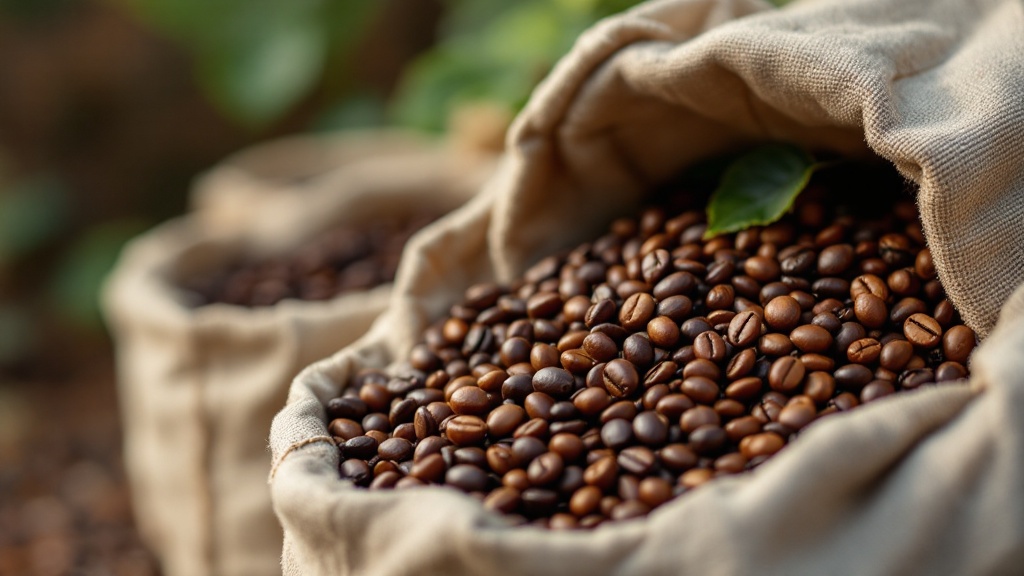“`html
1. Introduction

Did you know that improper storage can cause your coffee beans to lose up to 70% of their flavor within just two weeks? This blog explores the best practices for storing coffee beans to preserve their freshness, flavor, and aroma. Proper storage is essential for maximizing the lifespan and quality of your coffee beans.
Oxygen’s Impact on Coffee Degradation
The primary culprit in coffee bean deterioration is oxidation, a chemical process driven by exposure to oxygen. Oxygen reacts with volatile organic compounds (VOCs) present in the beans, initiating a cascade of reactions that lead to the degradation of aromatic compounds responsible for coffee’s nuanced flavor profile. These reactions are accelerated by increased temperature and humidity, forming undesirable compounds that contribute to off-flavors such as staleness, bitterness, and a loss of acidity. The rate of oxidation is not linear; it accelerates exponentially as exposure time increases. This means that the initial loss of flavor is relatively slow, but after a certain point, the degradation significantly increases.
“Proper storage isn’t just a step–it’s the key to unlocking 100% of your coffee’s flavor potential.”
– James Hoffmann, World Barista Champion and Coffee Expert
1. Introduction
2. Why Coffee Bean Storage Matters
3. Factors That Affect Coffee Bean Freshness
4. Best Practices for Coffee Bean Storage
5. Common Questions and Concerns
6. Tools and Materials for Optimal Storage
7. Expert Opinions and Real-World Examples
8. Practical Tips for Everyday Coffee Lovers
9. Related Topics and Applications
10. Conclusion
References
Unlock the Full Potential of Your Coffee Beans
- Roasted beans release CO2 initially, slowing down oxygen’s impact; this effect diminishes over time.
- Nitrogen flushing in packaging helps displace oxygen and extend shelf life significantly.
- Grinding coffee beans dramatically increases the surface area exposed to oxygen, accelerating oxidation.
- Storing coffee in airtight containers, away from heat and light, minimizes oxygen exposure.
- The type of coffee bean plays a role; lighter roasts oxidize faster than darker roasts due to higher VOC content.
| Key Aspect | Impact on Freshness | Storage Solution | Flavor Degradation |
|---|---|---|---|
| Oxygen Exposure | Accelerates oxidation, leading to off-flavors | Airtight containers, nitrogen flushing | Up to 70% flavor loss in 2 weeks |
| Grinding Beans | Increases surface area exposed to oxygen | Store whole beans, grind before brewing | Dramatically accelerates oxidation |
| Roast Type | Lighter roasts oxidize faster | Store darker roasts longer | Higher VOC content in lighter roasts |
2. Why Coffee Bean Storage Matters

The science behind coffee freshness is fascinating. Coffee beans release CO₂ (degassing) after roasting, which significantly impacts flavor. Exposure to air, light, heat, and moisture accelerates staling. Coffee beans lose their peak flavor within 2-4 weeks after roasting, even with proper storage. A study by the Specialty Coffee Association of America (formerly SCAA, now the SCA) found that beans stored in clear containers under light lost 30% more flavor than those stored in opaque containers. This highlights the importance of light-blocking storage.
CO₂ Degassing Kinetics
The post-roasting degassing of coffee beans is a complex process governed by Fick’s law of diffusion. This law dictates that the rate of CO₂ release is directly proportional to the partial pressure difference between the internal bean and the surrounding atmosphere and inversely proportional to the bean’s effective diffusion path length. The initial rapid degassing phase, occurring within the first few days post-roasting, is largely driven by the high initial internal pressure of CO₂. This phase is crucial as rapid release of CO₂ can lead to significant volatile compound loss if not properly managed. Optimal storage conditions should minimize the rate of pressure decrease to preserve volatile aromatic compounds.
“Light exposure degrades coffee flavor by 30%; opaque storage preserves freshness and maximizes peak taste.”
– Specialty Coffee Association, Coffee Science Research
- Bean size and density influence diffusion rate: Larger, denser beans degas slower.
- Temperature significantly impacts degassing speed: Higher temperatures accelerate CO₂ release.
- Relative humidity affects CO₂ solubility: Higher humidity can slow down degassing initially.
- The “second degassing” phase occurs more slowly over weeks/months.
- Proper degassing is crucial for maintaining crema and body in espresso.
- Packaging materials impact degassing rates; valve bags allow controlled CO₂ release.
3. Factors That Affect Coffee Bean Freshness

Coffee Bean Lipid Oxidation
Lipid oxidation is a critical factor determining coffee bean freshness and significantly impacts the final cup’s quality. This process, also known as rancidification, involves the degradation of unsaturated fatty acids within the bean’s lipids through a series of free radical reactions. These reactions are autocatalytic, meaning the initial oxidation products further catalyze the process, leading to a cascade effect that accelerates the degradation of the bean’s aromatic compounds and flavor precursors. The primary unsaturated fatty acids involved are linoleic and linolenic acid, which are highly susceptible to oxidation due to the presence of multiple double bonds in their molecular structure. The rate of lipid oxidation is influenced by several factors, including oxygen availability, temperature, light exposure, and the presence of pro-oxidants such as transition metal ions (e.g., iron and copper).
Air (Oxygen):
Oxygen causes oxidation, leading to stale flavors.
Solution:
Use airtight containers.
Light:
UV light breaks down coffee compounds.
Solution:
Store in opaque or tinted containers.
Heat:
High temperatures accelerate flavor degradation.
Solution:
Keep beans in a cool, dark place (60-75°F or 15-24°C).
Moisture:
Humidity can cause mold and spoil beans.
Solution:
Store in a dry environment and avoid refrigeration.
- Lipid oxidation produces off-flavors like cardboard, papery, or painty notes, diminishing the desirable aroma and taste of coffee.
- Antioxidants, naturally present in green coffee beans, can slow down oxidation but decrease over time and with roasting.
- The roasting process itself influences lipid oxidation; darker roasts generally exhibit higher levels due to increased heat exposure.
- Proper storage significantly impacts the rate of oxidation; minimizing exposure to oxygen, light, and heat is crucial for extending shelf life.
- The presence of free radicals during oxidation leads to the formation of volatile organic compounds, affecting the overall coffee aroma profile.
4. Best Practices for Coffee Bean Storage

Optimizing Coffee Bean Degassing
Proper degassing is crucial for maintaining the aroma and flavor profile of roasted coffee beans. The process, characterized by the release of carbon dioxide (CO2) produced during roasting, significantly impacts the overall sensory experience. Immediately post-roast, CO2 levels are exceptionally high, leading to potential issues such as uneven extraction during brewing and a compressed, muted flavor profile. Optimal degassing requires careful control of environmental factors. Insufficient degassing results in a sour, under-extracted cup, whereas excessive degassing can lead to stale, oxidized flavors. The rate of degassing is temperature and humidity dependent; higher temperatures accelerate the process.
Use Airtight Containers:
This prevents oxygen exposure. Containers with CO₂ valves are recommended for controlled degassing.
Block Light:
Use opaque or UV-resistant containers.
Control Temperature:
Store in a cool, dark pantry or cupboard.
Avoid Moisture:
Keep beans away from humid areas like the refrigerator.
Freezing (Optional):
Divide beans into small, airtight portions and use within 1-2 months for best results. Freezing is debated amongst experts, so proceed with caution.
- The peak degassing period typically lasts 7-10 days post-roast, but CO2 release continues for several weeks.
- Using a vacuum sealer can expedite degassing and further protect against oxidation.
- Ideal storage temperature is between 60-68°F (15-20°C) to balance degassing and oxidation.
- Whole beans degas slower than ground coffee, preserving freshness longer.
- Properly degassed beans extract more evenly, resulting in a sweeter, more balanced cup.
- Observe your beans; if they feel unusually hard or bloated, they may not have degassed sufficiently.
5. Common Questions and Concerns

Q1: Can I store coffee beans in the fridge or freezer?
Answer:
Freezing is a complex topic. While it can extend shelf life, improper freezing (e.g., frequent thawing) can cause moisture buildup and flavor loss. Expert James Hoffmann recommends freezing only if you vacuum-seal beans in small portions.
Q2: How long do coffee beans stay fresh?
Answer:
Whole beans stay fresh for 2-4 weeks after roasting; ground coffee loses freshness within minutes.
Q3: Should I buy whole beans or ground coffee?
Answer:
Whole beans retain freshness longer due to reduced surface area exposed to air.
Coffee Bean Cryopreservation
The optimal preservation of roasted coffee beans involves minimizing exposure to oxygen, moisture, and fluctuating temperatures. While refrigeration can slow down degradation, freezer storage presents a more complex scenario. The formation of ice crystals during freezing can damage the cellular structure of the bean, leading to a loss of volatile aromatic compounds responsible for the coffee’s nuanced flavor profile. This effect is exacerbated by repeated freeze-thaw cycles, as the ice crystals grow larger and cause more significant damage with each cycle. Vacuum sealing beans in small, airtight containers prior to freezing is crucial to mitigate these issues. The vacuum process removes oxygen, a major contributor to oxidation and rancidity, thus slowing down the degradation process. The smaller portions limit the amount of coffee exposed to temperature fluctuations during thawing, preventing large-scale ice crystal formation.
- Cryopreservation, while effective for some products, presents unique challenges for coffee due to its volatile aroma compounds.
- Liquid nitrogen freezing offers faster freezing rates, minimizing ice crystal formation compared to standard freezers.
- Properly cryopreserved beans can retain a significantly higher percentage of their original flavor compounds for extended periods.
- The type of coffee bean impacts its susceptibility to freeze damage; Arabica beans, for example, are often more sensitive than Robusta.
- Post-thaw handling is critical; rapid warming can still cause damage, so controlled thawing is recommended.
6. Tools and Materials for Optimal Storage

RAID Levels for Data Redundancy
Employing Redundant Array of Independent Disks (RAID) configurations is crucial for ensuring data redundancy and maximizing storage uptime in critical applications. The choice of RAID level directly impacts performance, storage capacity, and data protection capabilities. For instance, RAID 1 (mirroring) provides high data redundancy by duplicating all data across two or more disks, offering excellent read performance but reducing usable storage capacity by half. This is ideal for applications requiring high availability and data integrity, such as database servers or critical file servers. A real-world example would be deploying RAID 1 in a medical imaging system where data loss is unacceptable.
Airtight Containers:
Examples include Airscape Coffee Storage Canisters and Fellow Atmos Vacuum Canisters.
CO₂ Valve Bags:
Ideal for short-term storage.
Vacuum Sealers:
Useful for long-term freezing.
Labels and Markers:
Track roast dates and storage durations.
7. Expert Opinions and Real-World Examples

George Howell:
Recommends storing beans in airtight containers at room temperature and avoiding freezing unless necessary.
James Hoffmann:
Suggests using specialized coffee bags with one-way valves for short-term storage and freezing in small portions for long-term needs.
SCA Guidelines:
Advise against storing coffee in the refrigerator due to moisture and odor absorption.
Coffee Storage: Degassing Dynamics
The rate of coffee degassing significantly impacts flavor profile and shelf life. Degassing refers to the release of carbon dioxide (CO2) from roasted coffee beans, a process that begins immediately after roasting and continues for several weeks. This CO2 release is crucial, as trapped CO2 can negatively impact extraction during brewing, leading to a sour, under-extracted cup. However, uncontrolled degassing, especially in improperly sealed containers, can lead to rapid oxidation and staling, dramatically affecting flavor quality.
- Degassing is fastest in the first few days post-roast, slowing significantly after a week.
- Whole bean coffee degasses slower than ground coffee due to the larger surface area in ground beans.
- Proper storage in airtight containers slows oxidation, preserving freshness and aroma longer.
- Light roasts degas faster and more aggressively than dark roasts.
- One-way degassing valves in packaging allow CO2 to escape while preventing air ingress.
8. Practical Tips for Everyday Coffee Lovers

Optimal Coffee Extraction Ratios
Achieving optimal coffee extraction requires a precise understanding of the coffee-to-water ratio. This ratio, typically expressed as a mass ratio (e.g., 1:15, meaning 1 gram of coffee to 15 grams of water), significantly impacts the final brew’s flavor profile and overall quality. A ratio that is too low (under-extracted) will result in a sour, weak cup with underdeveloped flavors, while a ratio that is too high (over-extracted) will yield a bitter, astringent brew with burnt notes. The Goldilocks zone lies in finding the optimal balance.
Buy Smaller Quantities:
Purchase only what you can consume within 2-4 weeks.
Label Your Containers:
Note the roast date and bean type to track freshness.
Grind Just Before Brewing:
Maximizes flavor by reducing surface area exposed to air.
Experiment with Freezing:
Test small batches to see if it suits your taste preferences.
9. Related Topics
Coffee Roasting:
Understanding the roasting process helps determine optimal storage timelines.
Grinding Techniques:
Proper grinding complements storage by ensuring fresh flavor extraction.
Brewing Methods:
Different methods (e.g., espresso, pour-over) may require specific storage practices.
Sustainability:
Explore eco-friendly storage solutions, such as reusable containers and biodegradable packaging.
10. Conclusion

Proper coffee bean storage involves controlling air, light, heat, and moisture. Use airtight, opaque containers, store in a cool, dark place, and consider freezing for long-term needs if you follow best practices. Share your favorite coffee storage tips in the comments!
Oxygen’s Impact on Coffee Degradation
The oxidation of coffee lipids and aromatic compounds significantly impacts the organoleptic profile of roasted coffee beans. Exposure to oxygen initiates a cascade of chemical reactions, leading to the degradation of volatile aromatic compounds responsible for the nuanced flavor notes characteristic of a particular coffee origin and roast profile. These reactions are catalyzed by enzymatic activity within the bean itself, even after roasting, and accelerated by increased temperature and humidity. The result is a loss of desirable flavors, a decrease in acidity, and the development of stale or cardboard-like off-flavors. This process, often termed rancidification, is analogous to the spoilage observed in other lipid-rich foods. The rate of oxidation is directly proportional to the partial pressure of oxygen; therefore, minimizing oxygen exposure is paramount to preserving coffee quality.
References
- Howell, G. (2018).
The Coffee Roaster’s Companion
. - Hoffmann, J. (2014).
The World Atlas of Coffee
. - Specialty Coffee Association (SCA).
Best Practices for Coffee Storage
(This would require finding an updated SCA resource on this topic).
“““html
Unlock the Full Potential of Your Coffee Beans

By understanding the detrimental effects of air, light, heat, and moisture on your precious coffee beans, you can take proactive steps to preserve their vibrant flavors and aromas. Remember the key takeaways: airtight containers, opaque storage, cool temperatures, and a dry environment. Whether you choose a simple airtight canister or opt for the precision of freezing smaller portions, the effort you invest in proper storage translates directly to a richer, more enjoyable coffee experience.
Implementing these best practices isn’t just about extending the shelf life of your beans; it’s about unlocking their full potential. Imagine savoring that first cup, experiencing the full spectrum of flavors the roaster intended, weeks or even months after your purchase. This is the reward for mindful coffee bean storage. It’s the difference between a mundane morning brew and a truly exceptional coffee ritual.
So, take charge of your coffee destiny. Elevate your daily cup by implementing these simple yet powerful storage techniques. Your taste buds will thank you.
Minimizing Coffee Bean Oxidation
The primary degradation pathway for roasted coffee beans is oxidation, a chemical process involving the reaction of oxygen with the bean’s constituent compounds, particularly lipids and volatile aromatic precursors. This process leads to the loss of desirable flavor compounds, resulting in stale, flat tasting coffee. Oxygen exposure initiates a chain reaction, generating free radicals that further degrade the bean’s complex flavor profile. The rate of oxidation is accelerated by increased temperature and humidity, further emphasizing the importance of cool, dry storage conditions. Understanding the kinetics of oxidation is crucial in preserving coffee quality.
| Key Aspect | Storage Method | Impact on Flavor | Optimal Conditions |
|---|---|---|---|
| Air Exposure | Airtight containers | Prevents oxidation, preserves flavors | Minimize oxygen contact |
| Light Exposure | Opaque storage | Protects volatile aromas | Avoid direct light |
| Temperature | Cool storage | Slows oxidation, maintains freshness | Store in cool areas |
| Moisture | Dry environment | Prevents flavor degradation | Avoid humidity |
“`

